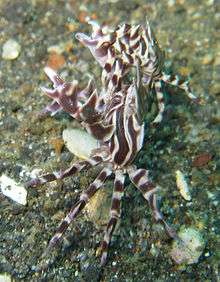Zebrida
Zebrida is a small genus of distinctive striped crabs, known as zebra crabs, that live in association with sea urchins in the Indo-Pacific.
| Zebrida | |
|---|---|
 | |
| Zebrida adamsii | |
| Scientific classification | |
| Kingdom: | |
| Phylum: | |
| Subphylum: | |
| Class: | |
| Order: | |
| Family: | |
| Subfamily: | Eumedoninae |
| Genus: | Zebrida White, 1847 |
| Species [1] | |
| |
Description
Zebrida was described by Arthur Adams as "a torpid, though elegant little crustacean".[2] It is "the most unusual" of the genera in the subfamily Eumedoninae, with long spines projecting from the body, and a distinctive pattern of stripes across the exoskeleton.[3]
Taxonomy and distribution
The genus was thought to be monotypic for a long time, but in 1999, Peter Ng & Diana Chia recognised two additional species, bringing the total number to three.[3]
- Zebrida adamsii is widespread in the Indian Ocean and western Pacific Ocean, from Japan to Australia.
- Zebrida brevicarinata is only known from Western Australia.
- Zebrida longispina is only known from Western Australia.
Ecology and life cycle
Crabs of the genus Zebrida live, often in pairs, in association with sea urchins,[4] including Toxopneustes pileolus, Toxopneustes elegans, Tripneustes gratilla, Diadema setosum, Asthenosoma ijimai, Salmacis bicolor, Salmacis virgulata, Heliocidaris crassispina, Pseudocentrotus depressus and a species of Acanthocidaris.[3][5]
Z. adamsii passes through four zoeal phases, and one megalopa phase before reaching the mature condition.[6]
References
- Peter Davie (2010). "Zebrida White, 1847". WoRMS. World Register of Marine Species. Retrieved January 21, 2012.
- Arthur Adams (1848). "Loo-Choo–Korea–Japan". In Edward Belcher (ed.). Narrative of the voyage of H.M.S. Samarang, during the years 1843–46: employed surveying the islands of the Eastern archipelago; accompanied by a brief vocabulary of the principal languages. 2. Reeve, Benham, and Reeve.
- Peter K. L. Ng & Diana G. B. Chia (1999). "Revision of the genus Zebrida White, 1847 (Crustacea: Decapoda: Brachyura: Eumedonidae)". Bulletin of Marine Science. 65 (2): 481–495.
- Gary C. B. Poore & Shane T. Ahyong (2004). "Zebrida White, 1847". Marine Decapod Crustacea of Southern Australia: a Guide to Identification. CSIRO Publishing. p. 451. ISBN 978-0-643-06906-0.
- Yasunobu Yanagisawa & Akira Hamaishi (1986). "Mate acquisition by a solitary crab Zebrida adamsii, a symbiont of the sea urchin". Journal of Ethology. 4 (2): 153–162. doi:10.1007/BF02348117.
- Atsushi Mori, Yasunobu Yanagisawa, Yasushi Fukuda & Peter K. L. Ng (1991). "Complete larval development of Zebrida adamsii White, 1847 (Decapoda: Brachyura), reared in the laboratory". Journal of Crustacean Biology. 11 (2): 292–304. doi:10.2307/1548366. JSTOR 1548366.CS1 maint: multiple names: authors list (link)
External links
